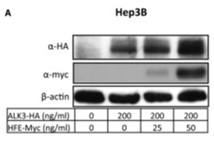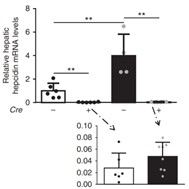HFE
-
Official Full Name
hemochromatosis -
Overview
Human hemochromatosis protein also known as the HFE protein is a protein which in humans is encoded by the HFE gene. The HFE gene is located on short arm of chromosome 6 at location 6p21.3. Unusually, the official gene symbol (HFE for High Iron Fe) is not an abbreviation of the official name (hemochromatosis) -
Synonyms
hemochromatosis;HFE;HH;HFE1;HLA-H;MVCD7;TFQTL2;hereditary;hemochromatosis protein;high Fe;MHC class I-like protein HFE;hereditary hemochromatosis protein HLA-H
Recombinant Proteins
- Rhesus macaque
- Human
- Mouse
- Rat
- Mus musculus
- Mammalian Cell
- HEK293
- Wheat Germ
- E.coli
- HEK293T
- In vitro E. coli expression system
- Mammalian cells
- E.coli expression system
- His
- Myc&DDK
- GST
- Non
- His&Fc&Avi
- His&Myc
- Flag
Background
What is HFE protein?
HFE gene (homeostatic iron regulator) is a protein coding gene which situated on the short arm of chromosome 6 at locus 6p22. HFE (Homeostatic Iron Regulator), or iron metabolism regulator, is a protein found on the surface of cells, mainly on liver and intestinal cells, but also found in some immune system cells. The HFE protein detects iron levels in the body by interacting with other cell surface proteins. HFE protein binds to transferrin receptor 1 (TfR1) and regulates iron levels, affecting iron absorption from the diet and release from storage points in the body. The HFE protein also regulates liver cells' production of a protein called hepcidin, which is a key factor in regulating iron absorption and release. The HFE protein is consisted of 348 amino acids and its molecular mass is approximately 40.1 kDa.
What is the function of HFE protein?
HFE helps regulate the absorption of dietary iron by the body. It interacts with the transferrin receptor 1 (TfR1) on the surface of cells, modulating the uptake of iron. HFE is involved in the regulation of hepcidin, a hormone produced by the liver that controls iron levels in the blood. When iron levels are high, HFE signaling leads to increased hepcidin production, which in turn reduces iron absorption in the gut and iron release from macrophages in the body. HFE has been implicated in immune responses, including antigen presentation, where it may play a role in the immune system's ability to recognize and respond to pathogens. HFE is suggested to have a role in modulating inflammatory responses, which can be relevant in conditions such as ankylosing spondylitis, where genetic variants of HFE are associated with the disease.

Fig1. A model of regulation of hepcidin transcription by iron. (James C Barton, 2015)
HFE Related Signaling Pathway
The bone morphogenetic protein (BMP) signaling pathway is central to the regulation of hepcidin expression, and HFE is a key component of this pathway. HFE interacts with the IL-6 signaling pathway, which is important for the inflammatory response and can influence hepcidin levels. HFE is involved in the activation of the NF-κB pathway, which can lead to the production of IL-6 and subsequently affect hepcidin expression. HFE affects the expression of ferroportin (FPN), the iron exporter, and thus plays a role in the regulation of iron transport from the gut into the bloodstream and its storage in cells. HFE's role in ferroptosis, a form of regulated cell death associated with iron and lipid peroxidation, has been suggested, particularly in the context of high-dose auranofin treatment.
HFE Related Diseases
The protein encoded by the HFE gene is a transcription factor that is involved in the regulation of iron metabolism. Mutations in the HFE gene can lead to iron overload, which can lead to a range of diseases, including hereditary hemochromatosis, non-alcoholic fatty liver disease, diabetes, and more. Hereditary haemochromatosis is the most common disease associated with the HFE protein, especially when the HFE gene has a C282Y homozygous mutation, resulting in reduced ferriregulator expression levels and increased iron absorption, causing iron overload. In addition, HFE gene mutations are also associated with some other diseases such as colon cancer, stomach cancer, liver cancer and so on.
Bioapplications of HFE
HFE mutation is the most common genetic cause of hereditary hemochromatosis, and HFE gene test is an important means to diagnose the disease. The role of the HFE protein in iron absorption and storage makes it a key target for studying iron metabolism, which could help develop strategies to treat iron overload or iron deficiency. Because HFE-related mutations are associated with an increased risk of liver disease, HFE genetic testing helps identify those patients who may benefit from early intervention.
Case Study
Case Study 1: Xing-Gang Wu, 2014
Mutations in HFE are the most common cause of hereditary hemochromatosis (HH). HFE mutation results in reduced expression of hepcidin, a hepatic hormone, which negatively regulates iron absorption from the duodenum and iron release from macrophages. However, the mechanism by which HFE regulates hepcidin expression in hepatocytes is not well understood. It is known that the bone morphogenetic protein (BMP) pathway plays a central role in controlling hepcidin expression in the liver. COS-7, HepG2, or Hep3B cells were lysed for immunoprecipitation and western blotting. Overexpression cells were used for protein degradation assay and protein biotinylation analysis. Here researchers show that HFE overexpression increased Smad1/5/8 phosphorylation and hepcidin expression, whereas inhibition of BMP signaling abolished HFE-induced hepcidin expression in Hep3B cells. HFE was found to associate with ALK3, inhibiting ALK3 ubiquitination and proteasomal degradation and increasing ALK3 protein expression and accumulation on the cell surface. The 2 HFE mutants associated with HH, HFE C282Y and HFE H63D, regulated ALK3 protein ubiquitination and trafficking differently, but both failed to increase ALK3 cell-surface expression.

Fig1. HFE increases hepcidin expression.

Fig2. HFE increases ALK3 protein expression in Hep3B cells.
Case Study 2: Lisa Traeger, 2018
Mutations in HFE, the most common cause of hereditary hemochromatosis, lead to iron overload. The iron overload is characterized by increased iron uptake due to lower levels of the hepatic, iron regulatory hormone hepcidin. HFE was cloned 21 years ago, but the signaling pathway is still unknown. Because bone morphogenetic protein (BMP) signaling is impaired in patients with hereditary hemochromatosis, and the interaction of HFE and the BMP type I receptor ALK3 was suggested in vitro, in vivo experiments were performed. In vivo, hepatocyte-specific Alk3-deficient and control mice were injected with either AAV2/8-Hfe-Flag or PBS. HFE overexpression in control mice results in increased hepatic hepcidin levels, p-Smad1/5 levels, and iron deficiency anemia, whereas overexpression of HFE in hepatocyte-specific Alk3-deficient mice results in no change in hepcidin, p-Smad1/5 levels, or blood parameters.

Fig3. Hepatic HFE protein expression of plasma-enriched membrane fractions is shown.

Fig4. In control animals, overexpression of HFE led to increased hepatic hepcidin mRNA expression.
Quality Guarantee
High Purity
.jpg)
Fig1. SDS-PAGE (HFE-4721H)
.
.jpg)
Fig2. SDS-PAGE (HFE-206H)
Involved Pathway
HFE involved in several pathways and played different roles in them. We selected most pathways HFE participated on our site, such as , which may be useful for your reference. Also, other proteins which involved in the same pathway with HFE were listed below. Creative BioMart supplied nearly all the proteins listed, you can search them on our site.
| Pathway Name | Pathway Related Protein |
|---|
Protein Function
HFE has several biochemical functions, for example, beta-2-microglobulin binding,co-receptor binding,NOT peptide antigen binding. Some of the functions are cooperated with other proteins, some of the functions could acted by HFE itself. We selected most functions HFE had, and list some proteins which have the same functions with HFE. You can find most of the proteins on our site.
| Function | Related Protein |
|---|---|
| protein binding | RAB5C,PPP1R37,SASS6,MAL,MYL12B,RBBP5,CSRP3,NOMO2,RABL2A,CT45A3 |
| receptor binding | WNT5B,FGF10A,CADM2A,PVRL1B,WNT7A,GFRA1,KCNA5,PLXNC1,NPFF,CD2 |
| co-receptor binding | TFR2,BMP2,NEO1,BMP4,DKK1 |
| NOT peptide antigen binding | FCGRT |
| transferrin receptor binding | HFE2,SNX4,SNX1,SNX2,CD81,Trf,TF,RGMA |
| beta-2-microglobulin binding | CD1C,CD1E,CD1D2,CD1B,CD1A,H2-Q10,HLA-A,CD1d1,FCGRT,CD1D |
Interacting Protein
HFE has direct interactions with proteins and molecules. Those interactions were detected by several methods such as yeast two hybrid, co-IP, pull-down and so on. We selected proteins and molecules interacted with HFE here. Most of them are supplied by our site. Hope this information will be useful for your research of HFE.
B2M;TFRC;pnp;q7chd9_yerpe;q81lj8_bacan;iolA2;TF;HSPA5
Resources
Related Services
Related Products
References
- Ghezelbash, F; Arjmand, N; et al. Effect of intervertebral translational flexibilities on estimations of trunk muscle forces, kinematics, loads, and stability. COMPUTER METHODS IN BIOMECHANICS AND BIOMEDICAL ENGINEERING 18:1760-1767(2015).
- Merono, T; Brites, F; et al. Metabolic alterations, HFE gene mutations and atherogenic lipoprotein modifications in patients with primary iron overload. CLINICAL SCIENCE 128:609-618(2015).


